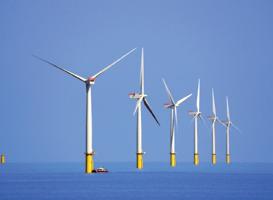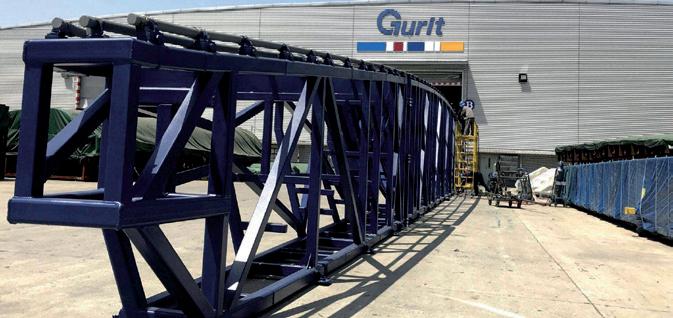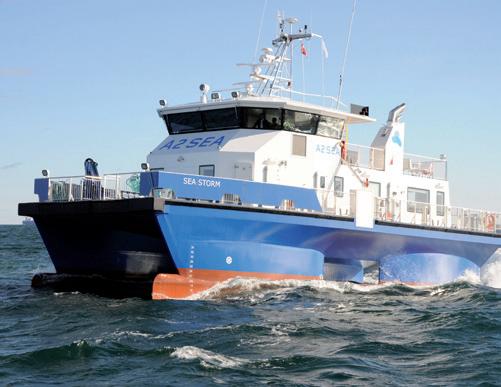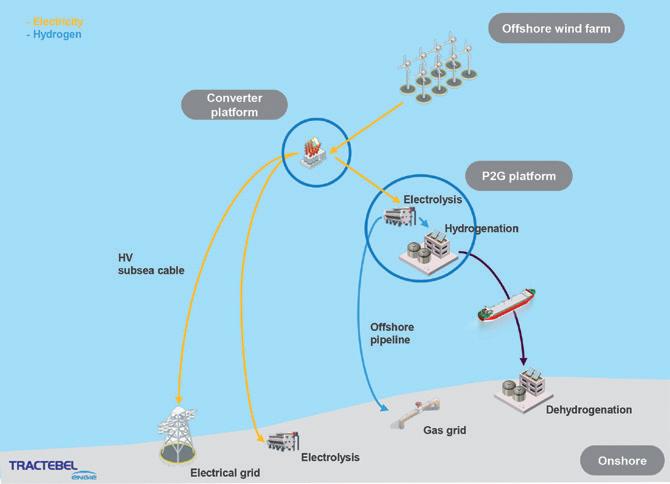
7 minute read
Growth of Offshore Wind Energy
Global energy demand is now increasing at its fastest pace ever and this trend does not look to be slowing. Currently, this additional demand is met largely through energy produced by fossil fuels, but there is a growing awareness of the need to reduce global carbon emissions.
To date, most clean energy is produced from hydropower dams; however, this is set to change with wind energy experiencing strong growth and advancements. In the USA, according to North American Windpower, wind turbines have already overtaken hydropower dams as the largest single source of clean energy.
UK as a pioneer in offshore wind
To date, the United Kingdom has been a key driver for offshore wind farms as it is surrounded by favourable shallow waters and consistent wind. Currently, five of the seven highest production wind farms are based here with the largest, Walney Extension, producing 659 megawatts (MW). This is however soon set to be eclipsed by both the Hornsea Wind Farm and Dogger Bank Wind Farm.
The majority of current wind power is produced by onshore turbines as they are initially cheaper to build and maintain, and energy is more easily transmitted. However, according to the International Energy Agency (IEA), offshore wind energy is experiencing strong growth, up 32% in 2017 and a further 20% in 2018 with strong results forecast for the following 5 years.
According to the Global Wind Report 2018, the total worldwide offshore wind power capacity was 18.8 gigawatts (GW) which represents around 4% of the total 591 GW produced from wind power in 2018. By 2025 the share is expected to exceed 10% with the total offshore wind power potentially reaching 100 GW.

Walney offshore wind farm
The Hornsea Wind Farm is currently under construction in the North Sea off the coast of England. The farm is being split into 4 subzones with each producing between 1-2 GW of power for a maximum supply of 6 GW. Construction of the first zone started in January 2018, with the first turbines sup
plying power to the UK national electricity grid from February 2019.
The offshore wind project “Dogger Bank” is similarly impressive and is set to power up to 4.5 million households through three connected wind farms, each expected to have a capacity of 1.2 GW, an equivalent to around 5% of Britain’s estimated power generation. The location is set to be around 130 kilometres off the British coast and will cover an area of 8,660 square kilometres with wind turbines 260m high, 70m higher than the largest existing offshore turbines.

Growth in Asia Challenges for offshore turbines
Despite this predicted growth offshore turbines do face their challenges. Leading edge erosion of wind blades is well documented and caused by the combined effect of rain impact and general weathering of the blades. For an onshore turbine, maintenance is relatively much easier and more accessible facilitating the reconditioning of blades. However, when the turbine is 130km offshore like The Dogger Bank Windfarm, this becomes much more difficult. If blades are not maintained sufficiently this erosion diminishes the blades aerodynamic efficiency which reduces its operational output and can eventually compromise the blade’s underlying composite structure if left unchecked.
Asia is also experiencing growth with investments in supply chains and projects continuing. India and Vietnam are in early stages but according to the Global Wind Report 2018, have an offshore wind potential of 60 GW and 27 GW respectively, with India setting a target of 5 GW by 2022 and 30 GW by 2030.
Japan is also showing potential for growth with a clear need to turn to offshore wind to meet an expected shortfall in power generation. The Japanese government have passed the Offshore Wind Law which provides them with a clear mandate to define several areas for offshore wind development. Another issue wind turbines face is the production of noise. The noise from blades comes from the tip vortex generation. This “hissing” sound is airborne and is dealt with by limiting wind blade tip speed to max 70m/s (ca 210 km/h) on onshore blades. Infrasound low-frequency noise is borne through the soil conditions and can be caused by machinery such as gearboxes. Inappropriate levels of infrasound are often cited as the source of a range of adverse health impacts; however, in 2019 the National Health and Medical Research Council found that there was no evidence that turbines directly affect health. The study did however call for further research on the effects within 1.5km of a turbine.
Early wind turbine designs in the 1980s produced large amounts of gear noise, however, modern designs are placing the rotors upwind of the turbine which has greatly reduced the noise and made turbines suitable for widespread use. The use of offshore wind farms places these turbines far enough away from the land that noise is typically unlikely to be heard.
Offshore wind turbines require a greater cost to establish and maintain and the technology to bring the power ashore is expensive. However, as the industry matures and larger turbines allow for additional economies of scale, the costs per kWh of power produced will continue to decrease. The offset of this is that offshore turbines tend to be more efficient with more predictable wind speed, have less interference with land use, and potentially help benefit the marine ecosystem where it is constructed thanks to the turbines underwater structure acting as an artificial reef.
Comprehensive offering
Gurit is well placed to handle this growth, having positioned Wind as a strategic focus. Today Gurit offers a complete package for customers building both onshore and offshore turbines: Tooling for wind blade moulds, composite materials and kitting services.
Bing Chen, General Manager of Gurit’s Tooling Business Unit states: “Gurit is the largest independent mould maker worldwide and as a result can provide a comprehensive offering including the development of master plugs and moulds to over 100 m in length, as well as a range of additional services including wind blade mould automation systems, installation services and transport systems for wind turbine blades and tower elements.”

Gantry of a Gurit tooling mould
Core materials made from recycled PET
On the materials front, Gurit’s Kerydn™ Green, which is produced from up to 100% recycled PET bottles, is an environmentally responsible material in line with the goals of wind energy.
www.gurit.com/wind

Workboat built with Gurit Corecell™, ferrying workers to and from nearshore wind farms
Workboats fulfilling their mission
Shape spoke with Gurit Engineering Manager APAC, Tony Stanton who advised Gurit has a huge range of capabilities in this area also: “Gurit offers excellent materials and an unrivalled composite engineering service that complements the material package and can provide smaller nearshore work vessels with maximum fuel efficiency. Using a SWATH (Small Waterplane Area Twin Hull) design with Gurit engineering and materials, customers can expect a high-speed transport vessel capable of partially submerging for an ultra-stable work platform.”
One of the noticeable differences with offshore wind farms is the requirement to venture far offshore and brave the weather conditions to build, maintain and repair them. Working vessels are the mode of choice as they allow economic travel and provide a working platform for crews. These rough crossings demand high-performance materials and Gurit’s Corecell™ M Foam is the perfect material to produce a highperformance boat subjected to the challenges the smaller near-shore workboats encounter.
Offshore wind generating green hydrogen

Tractebel hydrogen platform
https://tractebel-engie.com
The engineering firm Tractebel has developed an offshore wind-to-hydrogen platform. It converts electrical power generated by offshore wind turbines into hydrogen using electrolysis. With a capacity of 400 MW the installation has an industrial scale and exceeds the output of other solutions currently on the market. It allows the production of green, CO2-neutral hydrogen and can be used in existing gas pipelines. This combines various advantages. The natural fluctuations of wind can be easily stored as the electrolysis to produce the hydrogen can be easily scaled to the electricity available at any given moment or season. Secondly, the existing infrastructure for fossil fuels, in particular natural gas, could be converted into the production and transportation of hydrogen. This provides relief for the existing electricity grid or saves the cost of building electricity transmission lines to offshore hydrogen-wind farms. The potential is huge and this is certainly a promising opportunity to fight climate change.

https://tractebel-engie.com







